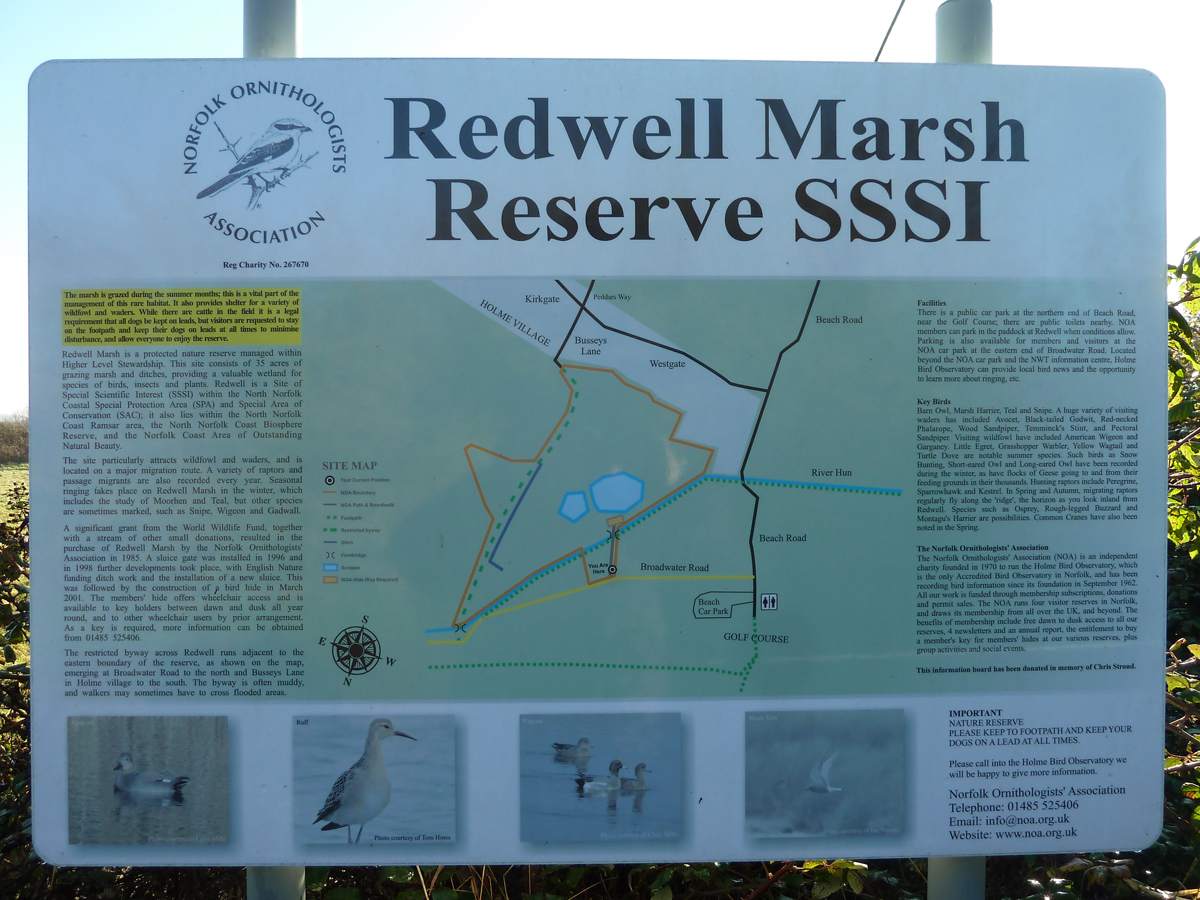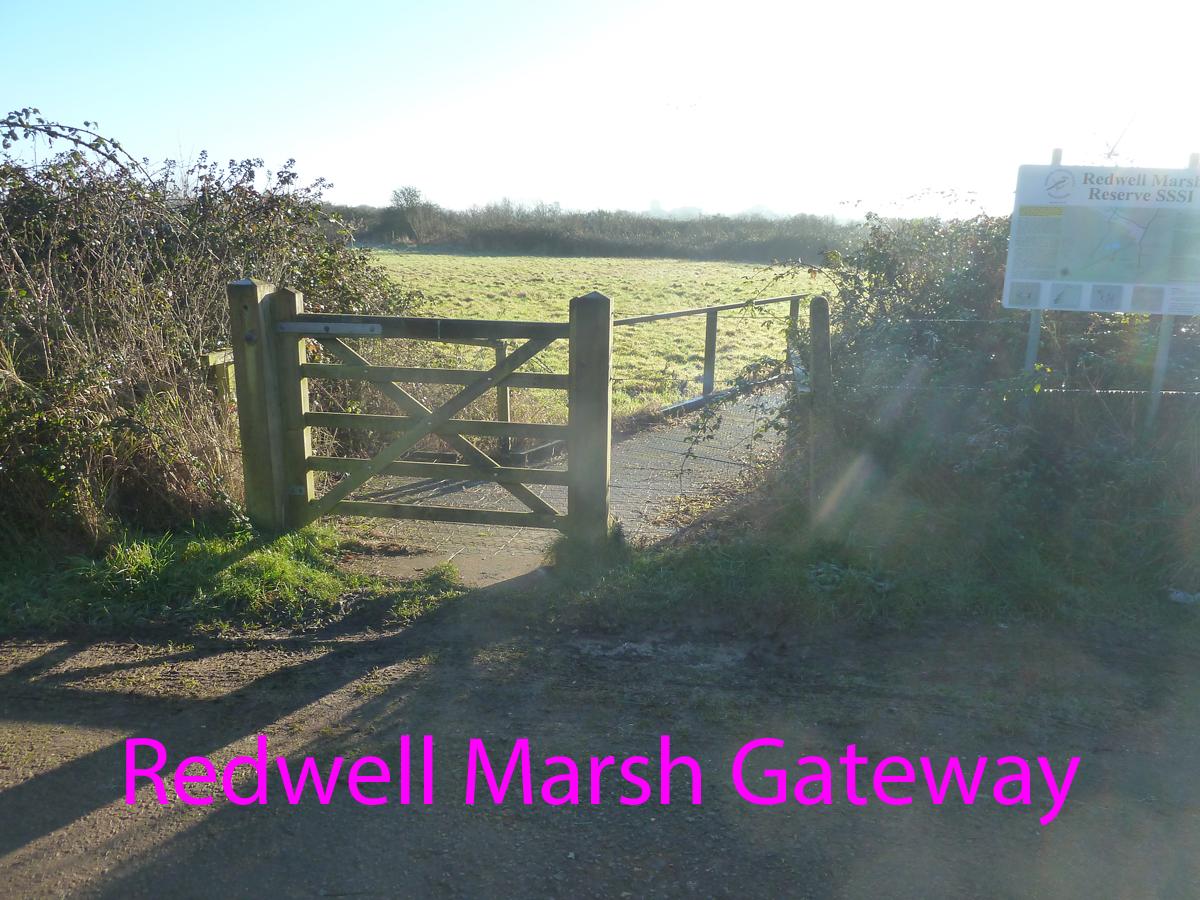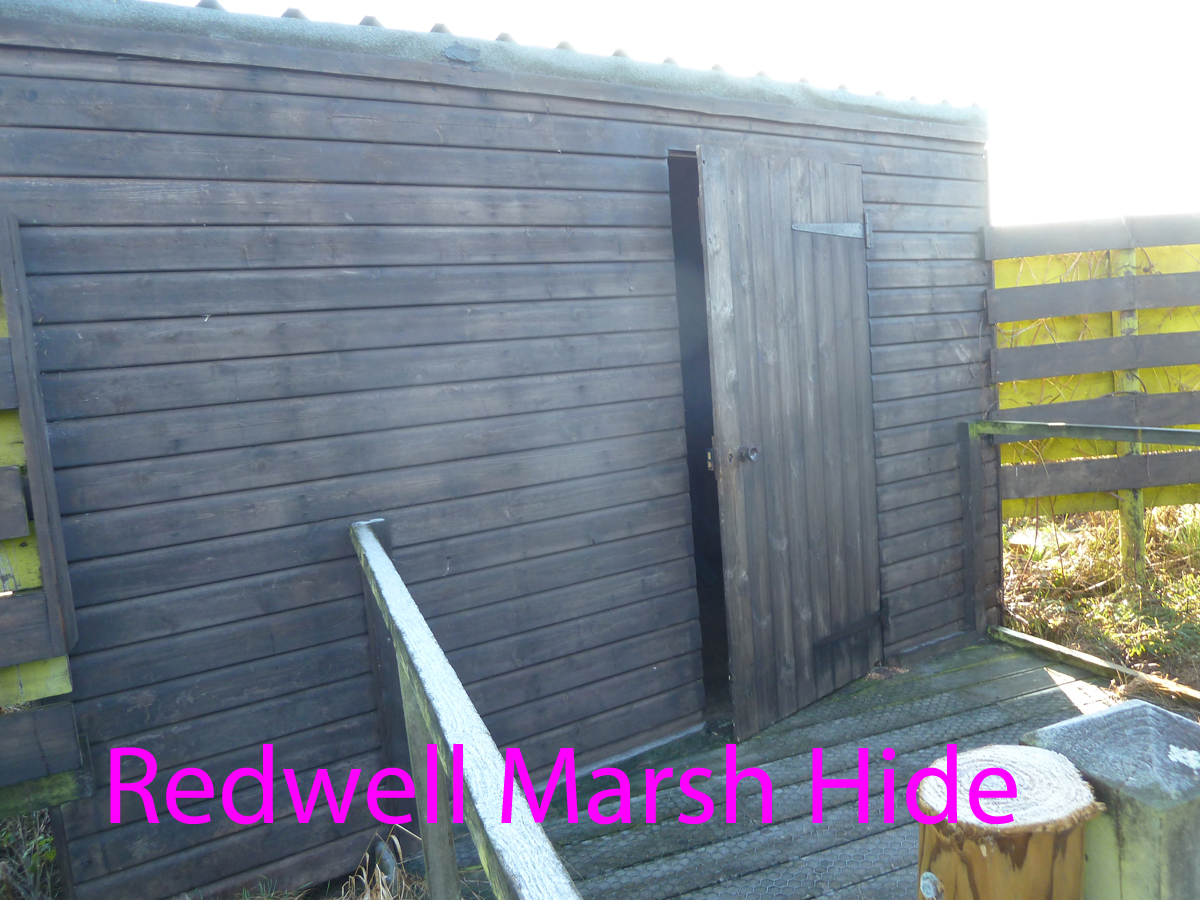Reserve Name: Redwell Marsh Reserve
Address: Broadwater Road, Holme-next-the-Sea, Hunstanton, Norfolk, PE36 6LQ
Phone Number: 01485 525406
Email: info@noa.org.uk
Opening Hours: Dawn to Dusk.
Website: Redwell Marsh Reserve
Map Reference: TF701437
Google Map: Redwell Marsh Reserve
(These notes should be read together with the parallel accessibility assessment notes for the NOA’s main reserve, which could easily be visited on the same day.)

Redwell Marsh Reserve is owned by The Norfolk Ornithologists’ Association (NOA). It is located within an extensive area of coastal habitats that are managed for wildlife conservation. The main NOA reserve surrounding its Observatory is located at the far end of the access road. Much work has been done over the years to make the Redwell Marsh hide wheelchair accessible. For full details see below.
The reserve was visited and assessed over a number of days during December 2016 by Peter Bangs.
Location: Holme next the Sea, Norfolk. Redwell Marsh reserve is located beside the tarmac-surfaced Broadwater Road, before the gated and gravel-surfaced section that leads onwards to the main NOA reserve.
Public Transport Links: The nearest bus stop is on A149, at the western end of Holme village. This is approximately 1.25 kms from the reserve, by the junction with Beach Road. The bus route is the Coasthopper, run by Stagecoach. Tel: 01553 776 980 Disability helpdesk Email: norfolk.enquiries@stagecoachbus.com Buses run from Kings Lynn (change may be needed at Hunstanton) or Wells.
At the bus stop there are raised paved areas (on each side of the road) to assist in boarding/alighting from the bus, but these are short and just end in an uneven grass verge. The road leading from the A149 towards the reserve (Beach Road) is narrow and twisting – in places a single-track road with a few passing places. There is no pavement, and for much of its length not even a grass verge. For this reason, it is not a suitable means of access for wheelchair users.
Parking: There is free parking near to this reserve, but it is limited. There is a gateway 25 metres beyond the main reserve entrance, with room for one car. In dry summer conditions cars may be parked in the grass field. In those dry conditions a car may be driven across the field to park near the boardwalk. However, there are no steps or ramps up from the field level to the boardwalk, so this may only be of benefit to some users. A small car may fit just by the reserve entrance, though the access road is quite narrow. There are spaces for minibuses by the gravel track. None of the parking is blue badge dedicated nor are accessible spaces signposted. The road beside the reserve has a tarmac surface, but further down Broadwater Road the surface is only gravel, which is frequently wet and potholed.
Drop Off: Passengers can be dropped off at the reserve entrance. There is more parking available beside Broadwater Road, but this is on a gravel section, and gets very wet after rain. In dry summer conditions, cars may be parked in the grass field next to the boardwalk, accessed via the field gate a short way down the road (see above). Another alternative would be to park a car at the northern end of Beach Road where there is a car park on the opposite side of the road from the public toilets. There are a few parking spaces beside the toilets, but these have a 1-hour time limit during the summer.
Toilets: The nearest accessible toilet, and standard toilet, is at the Public Conveniences at the northern end of Beach Road, c.0.5km from reserve. There is no public telephone and the mobile signal is very weak.
Staffing: There is a full-time warden at the main NOA Observatory (who may be out on the reserve, or in the bird ringing lab, near the main Observatory building), but not the Redwell Reserve.
Visitor Centre: There is no centre at Redwell Reserve itself, but visitors always receive a warm welcome at the Observatory building at the main NOA reserve. Guide dogs on leads are welcome.
Information: There are no leaflets. However, there is a large information / interpretation board, with a reserve map, at the entrance to the reserve.

The Reserve
General
Redwell Marsh is a protected nature reserve managed within Higher Level Stewardship. The site consists of 35 acres (14 ha) of grazing marsh and ditches, providing a valuable wetland habitat for many species of birds, insects and plants. Redwell Marsh is a Site of Special Scientific Interest (SSSI) within the North Norfolk Coast Special Protection Area (SPA) and Special Area of Conservation (SAC); it also lies within the North Norfolk Coast Ramsar area, the North Norfolk Coast Biosphere Reserve, and the Norfolk Coast Area of Outstanding Natural Beauty. The site lies on a major migration route, and freshwater scrapes have been created specifically to provide habitat for wildfowl during the winter, and for passage and breeding waders from spring through to autumn.
Birds
Key species at Redwell Marsh include Barn Owl, Marsh Harrier, Teal and Snipe. A wide variety of visiting waders includes regular visitors such as Avocet and Black-tailed Godwit, and scarcer species such as Red-necked Phalarope, Wood Sandpiper, Temminck’s Stint and Pectoral Sandpiper have been recorded. Visiting wildfowl have included American Wigeon and Garganey. In the summer, Little Egret, Spoonbill, Cuckoo and Turtle Dove are sometimes seen, and a variety of warblers are recorded. Short-eared Owls have been recorded during the winter, and flocks of Geese going to and from their feeding grounds in their thousands are a regular feature. Hunting raptors include Peregrine, Sparrowhawk and Kestrel. A variety of passerine migrants is also recorded every year, including many hirundines.
Access

The distance from the western inward-opening (150cms wide) entrance gate with the latch at 80cms, to the hide is about 70 metres. Halfway along is a passing place. There is a virtually flat and level boardwalk all the way from the western entrance gate to the hide and no trees etc., overhang it. The boards are at right angles to the path, about 1.55m wide, covered with wire netting for grip, and with upstands about 75mm high.There is a drop from the boardwalk down to the level of the field, with no side fencing, though the boardwalk is quite wide enough to keep away from that edge. Where the path goes over the River Hun there is side fencing.

The 88cms wide, outward-opening hide door is generally kept locked (members can buy a key). As the warden is not always on hand it would be wise to make contact in advance of your visit to ensure it is opened. It overlooks a large scrape and grazing marsh. The hide platform outside the door is 1.5m by 2m. Inside the wheelchair bay is 1.5m wide at least 600mm deep by 680mm high and angled. The shelf is 81cms from the floor and 17cms deep with viewing slots around 350mm high. In the wheelchair bay the flaps are both 82cms wide. They are light, with easy to grip fasteners with the top latch 120cms above the floor. In the hide there is room to turn a wheelchair around.
For non-wheelchair users there are gaps between fixed seats to slide legs around. Two plastic chairs are also provided for those needing back support.
There is another entrance to the reserve, about 200 metres further east. The approach to this entrance is over an area of rough grass. The gated entrance opens onto a grass field, which is uneven and muddy in wet weather. This eastern entrance gateway is mainly used by dog-walkers accessing a by-way that leads to Holme village, rather than bird-watchers, and is not wheelchair accessible. The main path is never less than 700mm wide.
